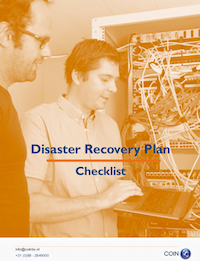Disaster Recovery Plan checklist
Every organisation should address the issue of Disaster Recovery to a greater or lesser degree.
After all, this is an essential aspect of Business Continuity. Disaster Recovery (DR) covers the fastest possible recovery of the IT environment following a disaster or disruption, for example the recovery of critical applications and regaining access to critical data – everything that is required in relation to IT to get your business up and running again after a disruption. Disaster Recovery and Business Continuity are terms that sometimes get mixed up.
Business Continuity covers the fastest possible continuation of all critical business processes following a disaster, part of which is IT. An organisation should therefore focus on all aspects of Business Continuity Management (BCM); IT, telephony, workstations and an up-to-date Business Continuity Plan (BCP).
Because the IT environment is an essential part of almost all companies, the availability of a Disaster Recovery Plan is a necessity and you can arrange for such a plan to be prepared by your own IT staff. A Disaster Recovery Plan Checklist can be helpful for that.
Checklist Disaster Recovery Plan (steps to view)
Checklist Disaster Recovery Plan
- Consider the purpose of the Disaster Recovery Plan in advance and decide what should and should not be included in the scope of the plan.
- Analyse the organisation’s IT systems and IT dependencies.
- Determine the Recovery Time Objective (RTO) for the critical applications and the Recovery Point Objective (RPO) for the critical data.
- Examine the current back-up schedule and check that it matches the RTO and the RPO.
- Ensure that the Disaster Recovery Plan focuses on systems that are necessary for continuation of the critical processes. If you don’t, there is a risk that the DRP will place priorities on non-critical aspects.
- Describe potential disruptions and the associated Disaster Recovery strategies; what action has to be taken for what disruptive event affecting what IT system.
- Describe the Disaster Recovery procedures and analyse:
- What steps have to be taken?
- Who is involved and what are the individual responsibilities?
- How long will it take to implement the step?
- What elements are required?
Do this separately for each phase (response, resumption and restore) and for each potential disruption. Set this out clearly in a table in excel for example.
Make a list of all Disaster Recovery contacts and make this part of the Disaster Recovery Plan. Ensure that the DRP is concise, clear and kept up-to-date. Appoint a document owner. This person will be responsible for DRP revisions and updates and will ensure that all relevant parties have access to the latest version. Regularly test the Disaster Recovery Plan or parts thereof.
TheDisaster Recovery Plan checklist can provide points of reference when preparing your DRP. Despite this, if you encounter specific problems then it may be helpful to call on external expertise, in which case make sure you engage a pragmatic party with relevant knowhow who can provide the necessary points of reference. After all, the content of the plan has to come from within your own organisation.
Please contact us if you have any questions about the Disaster Recovery Plan Checklist or if you would like to know more about Business Continuity.
DRP checklist assistance
Download the DRP checklist for your organisation. Need advice of personal help? Contact us.

